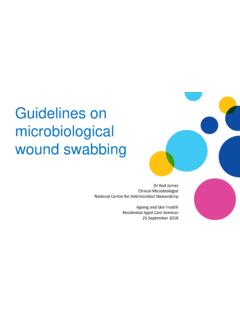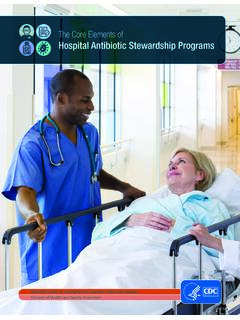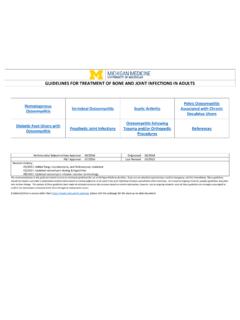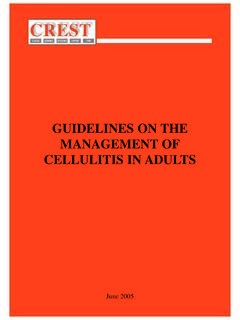Transcription of IDSA Guidelines on the Treatment of MRSA Infections in ...
1 August 15, 2011 Volume 84, Number 4 American Family Physician 455 The prevalence of methicillin-resistant Staph-ylococcus aureus (MRSA) in the United States continues to increase, with more than 94,000 cases of invasive disease reported in 2005. Illnesses caused by MRSA include skin and soft-tissue Infections , bacteremia and endo-carditis, pneumonia, bone and joint infec-tions, central nervous system disease, and toxic shock and sepsis syndromes. The Infec-tious Diseases Society of America (IDSA) has released its first evidence-based Guidelines on the Treatment of MRSA Infections . In addition to common clinical syndromes, the Guidelines address Treatment with vancomy-cin, limitations of susceptibility testing, and alternative therapies. skin and Soft-Tissue Infections in Community-Associated MRSAS imple abscesses or boils may be managed with incision and drainage alone; more data are needed on the use of antibiotics in this setting.
2 Antibiotics are recommended for patients who have abscesses associated with severe or extensive disease ( , multiple sites of infection) or rapid progression in the presence of associated cellulitis; signs and symptoms of systemic illness; associated comorbidities or immunosuppression; very young or very old age; abscesses in areas diffi-cult to drain ( , face, hand, genitalia); asso-ciated septic phlebitis; or lack of response to incision and drainage alone. empiric therapy for five to 10 days is recommended pending culture results for outpatients with purulent cellulitis. Infection from -hemolytic strep-tococci does not usually require empiric therapy. For those with nonpurulent cel-lulitis, five to 10 days of empiric therapy for -hemolytic streptococcal infection is recommended, based on the patient s clinical response.
3 empiric coverage for community- associated MRSA is recommended in patients who do not respond to beta-lactam antibiot-ics, and also may be considered in those with systemic antibiotic options for treating skin and soft-tissue Infections in patients with community-associated MRSA include clindamycin, trimethoprim/sulfamethoxa-zole (TMP/SMX; Bactrim, Septra), a tet-racycline (doxycycline or minocycline [Minocin]), and linezolid (Zyvox). Options for treating both -hemolytic streptococci and community-associated MRSA include clindamycin alone, TMP/SMX or a tetra-cycline in combination with a beta-lactam antibiotic ( , amoxicillin), or linezolid alone. Rifampin is not recommended for use as a single agent or adjunctive therapy. For hospitalized patients with complicated skin and soft-tissue Infections ( , deeper soft-tissue Infections , surgical or traumatic wound infection, major abscesses, cellulitis, or infected ulcers and burns), empiric ther-apy for MRSA should be considered pend-ing culture results, in addition to surgical debridement and broad-spectrum antibiotics.
4 empiric therapy options include intravenous vancomycin, linezolid (600 mg orally or intra-venously twice per day), daptomycin (Cubi-cin; 4 mg per kg intravenously once per day), telavancin (Vibativ; 10 mg per kg intrave-nously once per day), or clindamycin (600 mg IDSA Guidelines on the Treatment of MRSA Infections in Adults and ChildrenMARA LAMBERTC overage of Guidelines from other organizations does not imply endorse-ment by AFP or the collection of Practice Guidelines published in AFP is available at source: Infectious Diseases Society of AmericaEvidence rating system used? YesLiterature search described? YesPublished source: Clinical Infectious Diseases, February 1, 2011 Available at: GuidelinesDownloaded from the American Family Physician Web site at Copyright 2011 American Academy of Family Physicians.)
5 For the private, noncommercial use of one individual user of the Web site. All other rights reserved. Contact for copyright questions and/or permission Guidelines456 American Family Physician Volume 84, Number 4 August 15, 2011intravenously or orally three times per day). A beta-lactam antibiotic ( , cefazolin) may be considered in hospital-ized patients with nonpurulent cellulitis. MRSA-active therapy may be modified if there is no clinical response. Treatment for seven to 14 days is recommended, but should be individualized to the patient s clinical response. Cultures from abscesses and other purulent Infections are recommended in patients who have received anti-biotic therapy, those with severe local infection or signs of systemic illness, and those who have not responded adequately to initial Treatment .
6 Cultures are also recom-mended if there is concern of a cluster or children with minor skin Infections ( , impetigo) or secondarily infected lesions ( , eczema, ulcers, lac-erations), Treatment with mupirocin 2% topical cream (Bactroban) is recommended. Tetracyclines are not rec-ommended for children younger than eight years. Van-comycin is recommended in hospitalized children. If the child is stable without ongoing bacteremia or intravas-cular infection, empiric therapy with clindamycin (10 to 13 mg per kg intravenously every six to eight hours for a total of 40 mg per kg per day) is an option if the resistance rate is less than 10 percent. If the strain is susceptible, transition to oral therapy is advised. Linezolid may be considered as an alternative (600 mg orally or intrave-nously twice per day for children 12 years and older; 10 mg per kg orally or intravenously every eight hours for children younger than 12 years).
7 Recurrent MRSA skin and Soft-Tissue InfectionsPhysicians should provide instructions on personal hygiene and wound care for patients with skin and soft-tissue Infections . Patients should cover draining wounds with clean, dry bandages. Regular bathing is advised, as well as hand washing with soap and water or an alcohol-based hand gel, especially after touching infected skin or an item that has been in contact with a draining wound. Patients should also avoid reusing or sharing items that that have touched infected skin ( , disposable razors, linens, towels). Commercially available cleaners or deter-gents should be used to clean high-touch surfaces ( , doorknobs, counters, bathtubs, toilet seats) that may come in contact with bare skin or uncovered may be considered if a patient devel-ops a recurrent infection despite good personal hygiene and wound care, or if other household members develop Infections .
8 Strategies for decolonization include nasal decolonization with mupirocin twice per day for five to 10 days, or nasal decolonization with mupirocin twice per day for five to 10 days plus topical body decoloniza-tion with a skin antiseptic solution ( , chlorhexidine [Peridex]) for five to 14 days or dilute bleach baths. Dilute bleach baths can be made with 1 teaspoon of bleach per 1 gallon of water (or one-fourth cup per one-fourth bathtub or 13 gallons of water) and are given for 15 minutes twice per week for three months. Oral antimicrobial therapy is recommended only for treat-ing active infection and is not routinely recommended for decolonization. An oral agent in combination with rifampin, if the strain is susceptible, may be considered if Infections recur despite these measures. If household or interpersonal transmission is sus-pected, patients and contacts should be instructed to practice personal and environmental hygiene measures.
9 In symptomatic contacts, nasal and topical body decolo-nization strategies may be considered after treating the active infection. Decolonization strategies also may be considered in asymptomatic household contacts. The role of cultures in managing recurrent skin and soft-tissue Infections is limited. Screening cultures before decolonization are not routinely recommended if at least one of the previous Infections was caused by MRSA. Sur-veillance cultures after a decolonization regimen are not routinely recommended if there is no active Bacteremia and Infective EndocarditisBACTEREMIA AND INFECTIVE ENDOCARDITIS, NATIVE VALVEU ncomplicated bacteremia is defined as positive blood culture results and the following: exclusion of endocar-ditis; no implanted prostheses; follow-up blood cultures performed on specimens obtained two to four days after the initial set that do not grow MRSA; defervescence within 72 hours of initiating effective therapy; and no evidence of metastatic sites of infection.
10 Recommended Treatment for adults with uncomplicated bacteremia includes vancomycin or daptomycin at a dosage of 6 mg per kg intravenously once per day for at least two weeks. For adults with complicated bacteremia (positive blood culture results without meeting criteria for uncompli-cated bacteremia), four to six weeks of therapy is recom-mended, depending on the extent of infection. Some experts recommend higher dosages of daptomycin (8 to 10 mg per kg intravenously once per day). For adults with infective endocarditis, intravenous vancomycin or daptomycin (6 mg per kg intravenously once per day for six weeks) is recommended. Some experts recommend higher dosages of daptomycin (8 to 10 mg per kg intravenously once per day). Adding gentamicin or rifampin to vancomycin is not recom-mended in patients with bacteremia or native valve infective endocarditis.
















